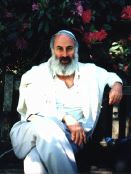Ph.D. Thesis at Brunel University, Uxbridge,
Department of Cybernetics.
by Yitzhak I. Khayut Man (Haissman/Hayut-Man), 1981

THE CYBERNETIC BASIS FOR HUMAN RECONSTRUCTION
An application for the Middle East
Abstract (see note: full thesis)
Chapter one explores the social implications of Gordon Pask's cybernetic Conversation Theory (CT) which has proved useful in the guidance of individual and small group learning, learning to learn, and even in the area of innovation. It then goes on to survey the current misunderstanding in the social sciences regarding Verstehen/ Understanding. This dispute has its origins in the great debate over man as an entity born chiefly for "action" as opposed to man as a "reasonable" being (Humes, 1748).
In our time, Verstehen has become a controversial issue, with academic polarization at such a point that there is no real dialogue between its proponents and detractors. Thus the author seeks to offer CT as an operational answer to the dispute. The conversational paradigm is presented through a structured ten-stage development (somewhat akin to the Kabbalistic construct of "The Tree of Life") that encompasses and extends the Action, Interaction, Games and Transaction paradigms currently used in the social sciences. Implications of CT are then explored both "positively" - in terms of "Human Reconstruction" - and "negatively" - in terms of conflict and conflict-resolution. Both lead to the need for specifying sequential descriptive guiding schemes termed here "redemptive scenarios". These "redemptive scenarios" are allegories for Human Reconstruction. Through their application, possible futures may be laid out by breaking down into constituent intermediate stages. This type of treatment, it is claimed, may be helpful in inducing the belief that little steps, changes, efforts, investments, etc. in the present can have a great impact on a better future. Conversational methods for their development are then presented, and the contemporary meaning of "redemption" is exemplified by case studies from modern "Dialogical Philosophy" (or "co-existentialism") in which "primary reality is based on conversation".
The second chapter provides a historic study of a socio-cultural entity - The Jewish People - that has anticipated many of these cybernetic developments. The discussion follows the structure of the preceding chapter to show how analogous constructs to the proposed cybernetic principles and tools have been employed with respectable results on a societal scale. The author sees an intimate connection between the function and methodology of the Talmud (the commentary on the Mishna, the Oral Law, and the "great collective work" of the Jewish People) and the concept of Verstehen/Understanding. The Talmud is seen to have constructed an enormous conversation domain which served, in turn, to reconstruct Judaism. The survey adds some insights into redemption from the Talmud and from Kabbalah, the Jewish mystical, esoteric discipline.
A progression similar to that outlined in chapter one is employed (assuming an external observer with no prior notions of Judaism), starting with "the simplest tool" for understanding the Jews -- i.e. "Physical Appearances"-- and bringing in such headings such as "Observable Behavior", "Observer's Perspective", "Torah and Halakha (Law) as Contract", "Judaism as Traditional-Ritualistic Culture", "Encounter of Judaism with Greek and Roman policies and methods", "Understanding the Mishnah and the Talmud", "Contacts with High Civilizations", "Kabbalah as Innovation and as Self-Understanding", before moving into analysis of the "conversational" and "reconstruction" aspects of the Mishnah and the Talmud.
In conclusion, the Middle East conflict is taken as a test case. From a starting point that originates with Buckminster Fuller's scheme for the "World Game", a different portrayal of the conflict is suggested for reconstructing the conflict. A special role is assigned to scientific endeavors which can explore and extend common grounds for forming understandings both between the contending parties and between their own disciplinary perspectives, so as to generate feasible and innovative solutions. The same constructions developed earlier are employed to sketch an interconnected system of simulations (called the "MECCA-HEJERA System") to guide and assess the feasibility of human reconstruction in the Middle East.
Prior to this, the foremost problem of the Middle East, namely, complexity, is analyzed in terms of the conflict created through confusion of perceptions. A small circuit is made of Middle East issues of the time, followed by a more in-depth assessment of specific Arab-Israeli disagreements. A survey of some "Prerequisites to Conversations" comes up against fundamental misunderstandings, relating to political ideology and religion, that restrict the opening of forums for dialogue at the inter-personal level. All of this is further exacerbated by the different types of "rationalities" and/or "sets of values" (which take different "sets off acts" into consideration) set in motion when Arab meets Israeli. Also discussed is the historically unconnected group name "The Palestinians" now used by nationalist Arabs. Anecdotal incidents involving the author's personal family members highlight some notable instances of Jew and Arab transcending their differences to engage in cooperative dialogue.
Note: The thesis is currently available only as microfiche service of all UK doctoral dissertations. However, the full thesis (on paper: about 400 pages and illustrated) is now (Sept 97) being re-typed, edited and re-illustrated for electronic media. The current update can be found at TheHOPE site. The diagrams, icons and structured staged schemes and perhaps even multimedia clips are being re-done and may be found in the Art Gallery section. All this may take several months to complete. If you are interested to read it, let us know and your interest may expedite the process. As intermediate measure, see the table of contents, so you can ask for a particular section.
Email: thehope@actcom.co.il
Back to Contents of this article
Main Contents of the Academy of Jerusalem
Main Contents of the Cyber Library |